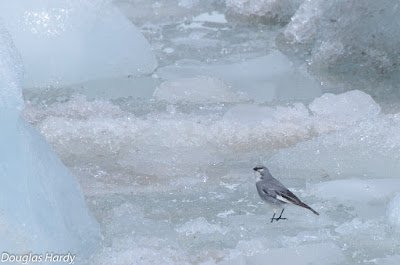We returned recently from an exciting 19 days of fieldwork at Quelccaya.
The expedition was timed to coincide with the conclusion of the wet
season following the very strong 2015-16 El Niño, and we gained
considerable new information. Specific objectives
related to this anomalous year included: AWS data recovery and annual
instrument maintenance; snowpit measurements and sampling for chemical analyses; and both GPS mass
balance and ice margin measurements. We also had an opportunity - which
for over a decade was only a dream - to spend time learning about and
documenting breeding behavior of the White-winged Diuca-Finch. This
species is among the highest-elevation nesting birds of the Western
Hemisphere, and is the only species known to build nests on glaciers
(see here for background, soon to be updated); our recent observations
yielded a wealth of new understandings. As always, Vicencio Expeditions
provided fantastic logistical support, allowing our team of 5 to work
safely and efficiently. Below is a quick collection of images
documenting some of our observations.
Fig. 1 (above): Quelccaya Ice Cap's western margin, at which our group spent 2+
weeks during April and early May. Note that the transient snowline is
already at nearly 5500 m, due to low accumulation and warmth during the
strong 2015-16 El Niño. Qori Kalis outlet glacier is partially visible
towards the left side of the image; our efforts on this trip were
concentrated at the outlet glacier just right of center.
Fig. 2: Alipampa Camp at the end of the road (4765 m), where we spent 2
nights acclimatizing. Snowfall overnight was somewhat unexpected.
Fig. 3: More snow, three mornings later, at Moraine Camp (~5200 m). Note frozen lake, as well as people and horse for scale.
Fig. 4: Quelccaya margin just south of the figure 1 panorama. Tiny
patches of new snow are visible on the otherwise-dark ablation zone of
the lower ice tongue. This low-albedo surface absorbs roughly half of
the solar radiation incident upon it on sunny days, becoming a maze of tiny meltwater
runoff channels.
Fig. 5: Qori Kalis outlet glacier, which has thinned dramatically in recent years - yet still extends into the lake.
Fig. 6: Mountain Guide Benjamin Felix Vicencio gets an overview of Qori Kalis.
Fig. 7: After several snowy days initially, high pressure built in over
Quelccaya, resulting in extensive melting at all elevations on the
glacier. Meltwater production led to hours of repeated calving at this ice face,
filling part of the lake with ice fragments.
Fig. 8: Meltwater runoff from the ice margin (above rocks in this view)
brought greater discharge to many streams than we had seen previously.
Fig. 9: Evidence from one of the runoff channels of high discharge
during the wet season; these are roots from a plant which had become
established near the stream.
Fig. 10: At the summit AWS, Felix is always eager to help. For the
past 12 years, the station's enclosures have been buried upon our
dry-season arrival. During the current El Niño event, accumulation was much
lower than normal. Indeed, at the end of April - with potentially 6-7
months of ablation ahead before the next wet season - accumulation
(w.e.) was less than any other year of the 2003 ice core record since
at least the late-19th century*! We will soon provide more details of
this extreme situation.
[*Caveats to this statement are required. Current accumulation is based on the amount present on 2 May 2016, above the 2015 dry season surface (water equivalence). This may under-estimate accumulation if a greater-than-normal proportion of precipitation was in the form of rain and percolated completely through the annual increment. Under-estimation could also occur if a greater proportion of meltwater percolated completely through, rather than refreezing within 2015-16 accumulation. However, the accumulation present in early May has always been less than that preserved when the subsequent wet season begins (due, for example, to dry-season sublimation).]
Fig. 11: The outlet glacier just above our camp, where a major focus of
the most-recent expedition was to study the breeding of Diuca speculifera or White-winged Diuca-Finch - the "Glacier Bird of the Andes".
Fig. 12: Four intensive days were spent searching for active nests,
which diucas build directly on glacier ice in well-protected, hidden locations (earlier, initial details
here).
Fig. 13: Locating active nests of any bird species requires patience
and astute observation skills. Extra motivation is required to do so in
the snow at elevations above 5000 meters.
Fig. 14: Two key members of the nest-searching team. All bird observations throughout the
entire expedition are available in eBird (~50 spp. from >4800 m).
Fig. 15: An adult Diuca speculifera seeking insects on floating ice fragments (see lake in figs 7 & 11).
Fig. 16: At the site of one diuca nest, high on a 60-meter cliff face.
Ideally - as in this case - the birds choose nest sites which are safe
from predation (esp. Fox, Pseudalopex culpaeus and Mountain Caracara, Phalcoboenus megalopterus)
and offer thermal protection (esp. heat loss by longwave radiation).
The actual nest site here is ~2 m to the right of the person.
Fig. 17: A juvenile diuca begging for food from a parent.
Fig. 18: Tremendous biodiversity exists in Cordillera Vilcanota. Here a
lizard basks in the sun adjacent to glacier ice (background), an
atypical environment for most lizard species.
Fig. 19: Quelccaya margin just south of the section we concentrated on
this time. A decade ago this margin was also a steep cliff, with
numerous diuca nests every year. However, over the past 30 years our
measurements with Dave Chadwell (Scripps & UCSD) document that the
glacier in this area has thinned by more than 60 meters (paper in review). Where will diucas nest in the future, as recession of the ice cap accelerates
and suitable locations disappear?
Fig. 20: Sunrise on Nevado Ausangate, highest peak of the Cordillera Vilcanota (6384 m).



















